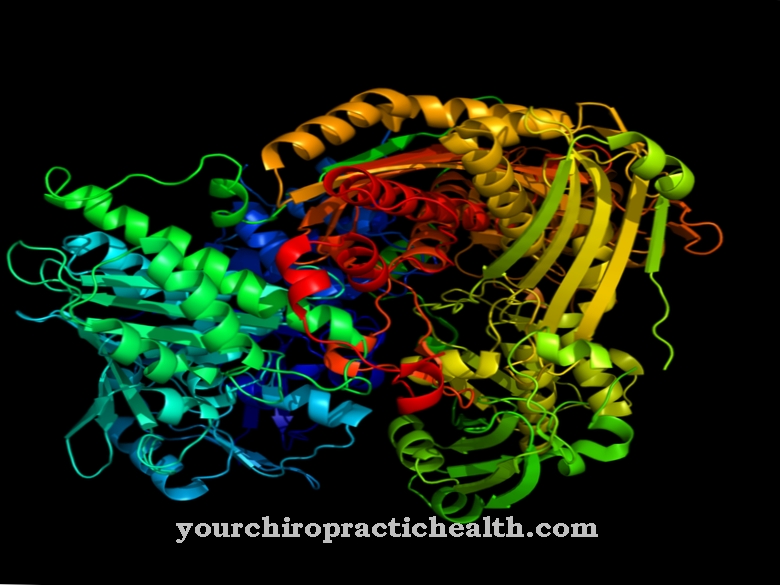Lysosomes are organelles in the cells of living things with developed cell nuclei (eukaryotes). The lysosomes are vesicles of a cell that are surrounded by a membrane and contain digestive enzymes. The task of the lysosomes kept in an acidic environment is to break down endogenous and exogenous substances and, if necessary, to initiate cellular destruction (apoptosis).
What is a lysosome?
Lysosomes are vesicles, i.e. small cell inclusions in eukaryotic cells, which are surrounded by a membrane and contain various intracellular, hydrolytic digestive enzymes inside. These are proteases, nucleases and lipases, i.e. digestive enzymes that can break down and break down proteins, nucleic acids and fats.
The fragments are either broken down further and partially disposed of or reused by the metabolism, so to speak recycled. Lysosomes are therefore also referred to as the cell's own stomach. The interior of the lysosomes with a diameter of 0.1 to 1.1 micrometers is kept in an acidic medium with a pH of 4.5 to 5.0 by the activity of proton pumps. The strongly acidic environment serves to protect the cell itself, because the enzymes are only active in an acidic environment.
If a lysosome empties its enzymes into the pH-neutral cytosol, they are deactivated immediately and are harmless to the cell. So that the membrane itself is not attacked by the digestive enzymes, the membrane proteins are heavily glycosylated on the inside.
Function, effect & tasks
The main job of the lysosomes is to provide hydrolytic digestive enzymes to break down proteins, nucleic acids and fats when needed. These can be substances that are foreign to the cell or their own. The breakdown of cellular substances also includes apoptosis, the preprogrammed cell death in which the lysosomes with their enzymes take on an essential technical function.
Non-cellular particles that are in the extracellular space and are intended for degradation are first transported into the cell by endocytosis. The outer cell membrane turns inside out, flows around the substance to be broken down and then splits off from the cell membrane as an independent vesicle. The vesicles fuse with lysosomes so that the breakdown process can begin. The process of endocytosis and fusion with a lysosome always takes place without direct contact with the cytoplasm and is comparable to phagocytosis.
As part of the independent cell renewal process, other organelles and components of the cytosol are also fed to the lysosomes for “decomposition”. As a rule, the fragments are reused for the reconstruction of amino acids, proteins, nucleic acids and carbohydrates, i.e. recycled. The lysosomes also play an important role in apoptosis, the programmed cell death. The cell that has received the signal for apoptosis is shrunk and dismantled following a certain program, without parts of the cell getting into the extracellular space, where inflammatory reactions would take place immediately.
Education, occurrence, properties & optimal values
Practically, with very few exceptions, lysosomes occur in every cell of the eukaryotes. Only the number of lysosomes per cell varies depending on the cell type and the tasks of the cell in the tissue. The hydrolytic enzymes and the proteins of the lysosome membrane are synthesized by ribosomes on the endoplasmic reticulum (ER). They are then marked in the trans-Golgi apparatus so that they are not haphazardly transported into any lysosomes.
The most important role in labeling is played by a phosphotransferase and another enzyme that completes the labeling process. The acidic environment within the lysosomes is ensured by a V-type ATPase. The enzyme splits off 2 H + ions from ATP via the process of hydrolysis and transports them into the lysosome. Lysosomes are involved in a large number of internal and external metabolic processes. A direct or indirect measurement of their number is not possible and would have little informative value. Therefore, no statement can be made about an optimal number of lysosomes. Any malfunctions in the lysosomes are usually very noticeable.
Diseases & Disorders
There are several known lysosome dysfunction that lead to serious illness. A very rarely occurring - genetic - functional disorder is triggered by a defect in the phosphotransferase. The inoperable enzyme leads to an uncontrolled release of the lysosomal enzymes into the extracellular matrix.
At the same time there is an accumulation of lipids, mucopolysaccharides and glycoproteins in the lysosomes, which are actually intended for degradation and degradation. But since there are no digestive enzymes due to their misdirection, the substances accumulate more and more in the lysosomes. This autosomal, recessive inherited lysosomal storage disease, known as I-cell disease, is based on a mutation in the GNPTAB gene. Other lysosomal storage diseases are known, but they are based on incorrectly synthesized hydrolases. Similar to I-cell disease, here too there are accumulations of undegraded proteins, nucleic acids and lipids.
All lysosomal storage diseases have in common that the ratio of substances introduced and substances discharged from the lysosomes is disturbed at the expense of the substances to be discharged. There is a veritable congestion within the lysosomes. The storage diseases usually take a serious course and are not curable in terms of eliminating the cause.
Another risk arises when taking lipophilic medication with a weak base. They can pass through the membranes of the lysosomes in a neutral form from the outside to the inside, but not in the opposite direction if they are protonated by the acidic environment within the lysosomes, so that lysosomotropy, an accumulation of drugs in the lysosomes, can occur .The medicinal substances in the lysosomes can reach a concentration 100 to 1000 times the concentration in the blood plasma.












.jpg)

.jpg)
.jpg)











.jpg)